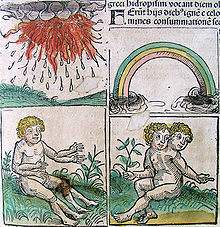Omen
This article needs additional citations for verification. (April 2008) |

An omen (also called portent) is a phenomenon that is believed to foretell the future, often signifying the advent of change.[2] It was commonly believed in ancient times, and still believed by some today, that omens bring divine messages from the gods.[3]
These omens include natural phenomena, for example an
Though the word omen is usually devoid of reference to the change's nature, hence being possibly either "good" or "bad", the term is more often used in a foreboding sense, as with the word ominous. The word comes from its Latin equivalent omen, of otherwise uncertain origin.[4]
Ancient Near East
This section relies largely or entirely on a single source. (August 2016) |
The oldest source for this practice in the Ancient Near East came from Mesopotamian practice attested at the first half of the 2nd millennium BC. It was vigorously pursued by the Assyrian kings, Esarhaddon and his son, Ashurbanipal in the 7th century BC.[3]
Omens were interpreted by several methods—e.g., liver divination,
Astrological omens were popular in Assyria in the 7th century BC. Diviners gained influence by interpreting omens and advising the king, Esarhaddon (681–669 BC), how to avoid some terrible fate. Sometimes the Assyrian king hid for a while after he put a substitute king on the throne. The court expected that the substitute king would take the evil consequences of an omen. When they believed the danger was over, they executed the substitute king and the true king resumed the throne.[3]
The observations of omens were recorded into series. Some of them dated back to the first half of the 2nd millennium BC, and these were arranged as conditional statement later (if such and such is the case, then such and such is the result).[3]
This belief of omens later spread out around the Near East and beyond when clay models of sheep livers used for the diviners to learn the craft was found in Boghazkoi, Ugarit, Megiddo, and Hazor.[3]
Letters from the city Mari dated at the latest from the 18th century showed that these divinatory practices were not limited to the royal court, but also played an important role in everyday life of the people.[3]
Ancient Greece
An oionos (omen) was defined in antiquity as the carnivorous vulture, especially a prophetic bird. By careful observation of the bird's cries and the way or direction it flew, the augurs attempted to predict the future. They also saw lightning or thunder as omens, sent from Zeus, and observed the direction in which they saw or heard them. Omens represented the divine will and the decisions of the gods, their positioning opposite human endeavors, and were aimed at being understood by sensitive receivers of the time, who brought the divine charisma to become intermediaries, channels between the world of gods and humans. Even since Homeric times, the Greeks paid special attention to these signs: when they saw vultures from the left, another symbol of Zeus, they considered it a bad omen. The cry of a heron or lightning to the right marked positive and promising omen. In the Greek territory, seers also judged good and bad omens from the unwillingness or willingness of a victim to approach the altar and by the state of its offal when slaughtered.[5]
Ancient Rome
In
Many Romans believed that particular words, phrases or incidents might carry prophetic content aimed at particular individuals who witnessed or heard them. Such "private" omens could be accepted, and their benefits secured (or their threat averted) by use of countersigns, or verbal formulas such as accepit omen, arripuit omen ("I accept the omen, I hold to it"); the consul
Astrology
In the field of
See also
- Augury – Roman religious practice
- Coincidence – Concurrence of events with no connection
- Delusions of reference – Phenomenon involving innocuous events
- Divination – Attempt to gain insight into a question or situation
- Eclipse of Thales – Solar Eclipse
- Luck – Concept that defines the experience of notably positive, negative, or improbable events
- Parapsychology – Study of paranormal and psychic phenomena
- Superstitions in Muslim societies – Folk belief in Islam
- The Omen – 1976 film by Richard Donner
References
- ^ "The Heavens - World Treasures: Beginnings - Exhibitions - Library of Congress". loc.gov. 29 July 2010.
- ^ Princeton. "Omen". Retrieved 8 March 2011.
- ^ ISBN 9780300140057.)
{{cite book}}: CS1 maint: multiple names: authors list (link - ^ Online Etymology Dictionary. "Omen". Douglas Harper. Retrieved 8 March 2011.
- ^ a b Lampsas Giannis, Dictionary of the Ancient World (Lexiko tou Archaiou Kosmou), Vol. I, Athens, Domi Publications, 1984, pp. 43–44.
- ^ Donald Lateiner, "Signifying Names and Other Ominous Accidental Utterances in Classical Historiography", Greek, Roman, and Byzantine Studies, (2005), 49."Archived copy" (PDF). Archived from the original (PDF) on 2010-06-14. Retrieved 2010-04-30.
{{cite web}}: CS1 maint: archived copy as title (link) - ^ See Veit Rosenberger, in Rüpke, Jörg (Editor), A Companion to Roman Religion, Wiley-Blackwell, 2007, p.298; citing Cicero, De Divinatione, 2.77.
- ^ Wardle, D., (Editor), Cicero on Divination, Book 1, Clarendon Ancient History Series, 2006, p. 74
- ^ "If we are going to accept chance utterances of this kind as omens, we had better look out when we stumble, or break a shoe-string, or sneeze!" Cicero De Divinatione 2.84: Loeb translation (1923) online at Bill Thayer's site [1]. In Pliny, Historia Naturalis, 15.83: ex hoc genere sunt, ut diximus, cottana et caricae quaeque conscendendi navem adversus Parthos omen fecere M. Crasso venales praedicantes voce, Cavneae. Teubner-Mahoff edn. transcribed at Bill Thayer's site [2]
- ^ The Lives of Twelve Caesars, Life of Caligula 57 Archived 2021-07-13 at the Wayback Machine
